By Robert Bruce
Robert Bruce’s two-part report on the U.S. Navy’s Riverine Forces concludes here with an in-depth look at the guns and gear of Riverine Security Teams. While the primary mission of these specialized Sailors is armed reconnaissance ashore, they are also essential augmentations to firepower on the boats.

Guns of the Riverine Security Teams
The twelve men of a Riverine Security Team (RST) are the detachment’s landing force, Sailors who go ashore primarily for reconnaissance but also a variety of other “muddy boots missions.” The team is often augmented by an Intelligence Specialist for information collection and a Hospital Corpsman for medical support.
New RSTs receive initial training in the same basic skill sets as boat crewmen, including Expeditionary Combat and Riverine Combat. This is followed by several weeks of specialized Security Team instruction before assignment to a detachment.
After coming aboard, their Advanced Unit Level Training is heavy on mastery of individual weapons including fast transition from carbine to pistol. They learn to effectively engage moving targets, provide supporting fire as a unit, fire and maneuver, and utilize signaling devices such as smoke grenades and pop flares.
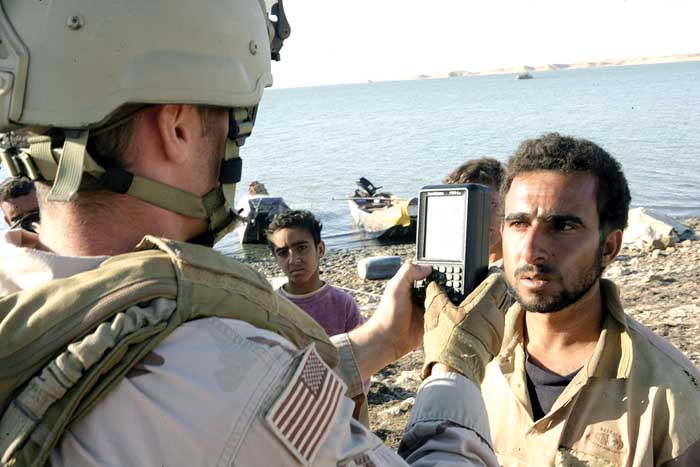
Battle drills training consists of small unit maneuver tactics and patrolling formations, insertions and extractions both hot (under fire) and cold, as well as verbal and non-verbal communications with supporting watercraft. AMOUT (Advanced Movement in Urban Terrain) is also emphasized where RSTs learn techniques for patrolling in villages and towns, how to conduct two and four man room entries, and defensive strong pointing of buildings.
RSTs are well armed with a variety of standard U.S. military small arms that allow a fast and furious response to situations both likely and unexpected. As with Riverine boat crewmen, they carry both the 9mm Beretta M9 semiautomatic pistol and the 5.56mm Colt M4 series selective fire assault carbine.
These flattop M4s feature adjustable telescoping buttstocks and are topped with Aimpoint no-magnification red dot reflex sights or Trijicon ACOG 4 power day scopes. The carbine’s Rail Accessory System forearm carries the AN/PEQ-15 laser aiming device with its pressure switch usually taped on a detachable vertical foregrip. A visible beam tactical light is optional for selected missions.
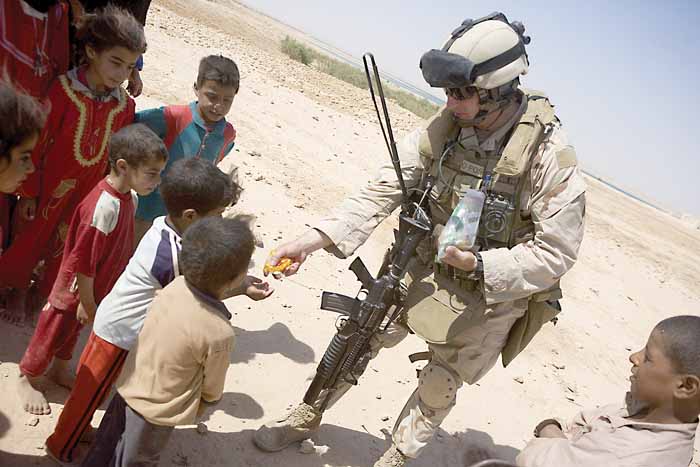
There are six Riverines on each of the detachment’s two fire teams, consisting of a patrol leader, grenadier, machine gunner, and three riflemen. Grenadiers have single shot 40mm M203 grenade launchers clamped under their M4s and the machine gunner is formidably armed with the 7.62mm belt-fed FN MK 48. 12 gauge Mossberg M500 pump shotguns are carried when needed for door breaching and room clearing.
Depending on the specific mission, a team member who has undergone additional specialized training in long range precision shooting with the powerful 7.62mm M14 rifle may perform as a Designated Marksman. Additional duties for selected RSTs include Navigator, Communicator (radio operator) and JTAC (Joint Terminal Attack Controller) who skillfully directs the awesome firepower of attack aircraft or artillery.
RSTs also receive training on all of the boat-mounted crew served weapons so they will be able to effectively man the guns in the event a designated gunner is out of action. They become proficient in the use of Combat Rubber Raiding Craft (Zodiacs) for stealthy waterborne insertions and extractions. They provide impressive supplementary firepower to ground convoys as well as strengthening defense and security of the detachment’s landside base of operations. The Art and Science of Hot Extractions
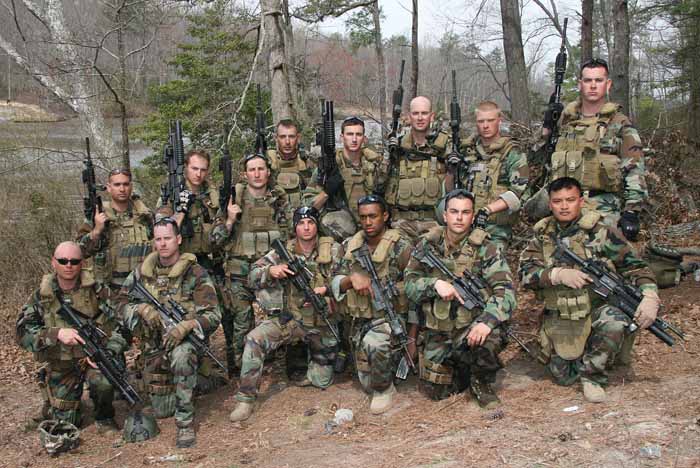
A week after our first meeting we caught up with Det 1 at the U.S. Army’s Fort A. P. Hill, about 235 miles to the north of Lejeune and a conveniently short duration vehicle convoy just 75 miles northwest of the unit’s home base at Yorktown Naval Weapons Station, Virginia. Yorktown-based defense contractor ITA International was advancing the detachment’s training evolution at Lejeune with some intensive practical exercises for the Riverines in live fire from multiple boats maneuvering at White’s Lake Tactical Raft Training Site.
Lieutenant (JG) William Ashley, Detachment 1’s serious but personable OIC, explained that ever since coming out of Iraq in December 2008, his unit has been in the post-deployment/pre-deployment training cycle, gearing up for its next assignment.
Now, building on extensive static landside shooting of crew served weapons and small arms, as well as preparatory weapons training while underway, it was time to move up to waterborne ops with boats moving and shooting in confined space. White’s Lake multipurpose range, Ashley said, adequately supports some typical riverine fire and maneuver missions, in this case insertions and “hot extractions” of Riverine Security Teams.
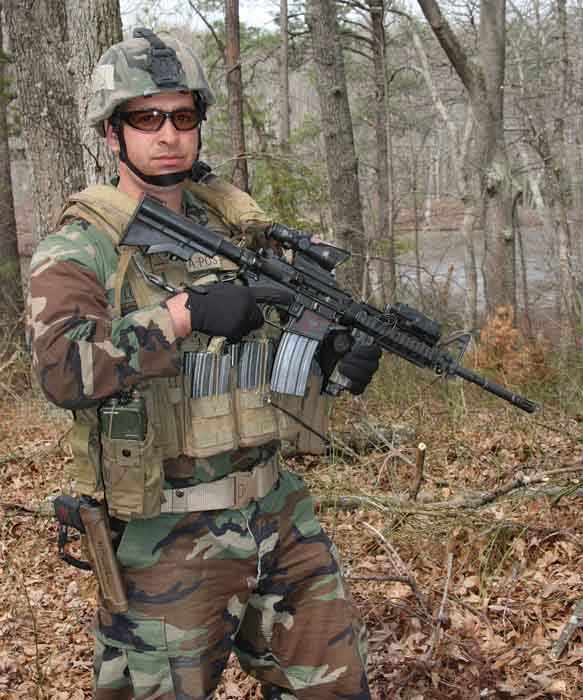
“They’ll be inserting an RST, about six guys, into the woods,” Ashley explained. “They’ll be doing their maneuvers while the boats are shadowing them. The RST will take (simulated) contact, start firing and make their way back towards the lakeside/river. As they mark their flanks the boats will engage their contacts at the same time they’re moving in to extract the ground team. And as they ‘exfil’ (exfiltrate) the area, they’ll be engaging the targets. We’ll be doing that in several iterations with different crew swaps.”
Because each boat has two crews and the RST has two separate fire teams, there was plenty of time to observe preparations and conduct of this flexibly choreographed live fire training. We also had time to interview an RST member under the watchful eye of Lieutenant (JG) Jeremy Baer, Assistant OIC of Det 1, RIVRON THREE. Don’t Get Off The Boat?
John Paul “JP” Lubrani, Hull Technician 2 (EXW) is a native of Venice Beach, Los Angeles, CA. He’s 31 years old with seven and a half years in the Navy, the last two in Detachment 1. He started as a boat crewman and then began working with the RST while on deployment to Iraq. JP said that he is one of the first to be dual qualified for both boat crew and RST, where he is the assistant JTAC (Joint Terminal Attack Controller) in training. His awards include the Navy and Marine Corps Achievement Medal and the Expeditionary Warfare pin.
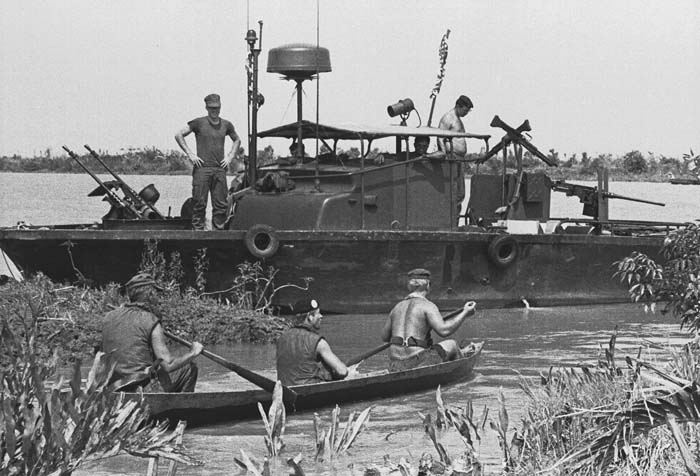
SAR: You were originally a gunner on a Riverine boat and then volunteered for RST. Didn’t you see the movie Apocalypse Now and know not to get off the boat?
Lubrani: (laughs) ‘Chef – never get off the boat!’
SAR: You joined the Navy soon after the terrorist attacks of 9-11-01. Is this why you enlisted?
Lubrani: I had a daughter and I wanted to join for her. I didn’t want anyone else to fight my fight. It was up to me. I spent about five years in the LCAC (Landing Craft Air Cushion) community then asked for assignment to Riverine because it sounded like it was something above and beyond what I was currently doing. I wanted to see if I could push myself to those limitations.
SAR: Has this assignment lived up to your expectations?
Lubrani: Yes it has, 110 percent. It’s physically demanding, mentally demanding, very challenging all around. Every time you complete something they set a new standard, a new bar that you’ve got to try to achieve so we keep rising.
SAR: How are the living conditions in a Riverine unit? No snack bar, you don’t get movies on the boat at night or a lot of hot chow.
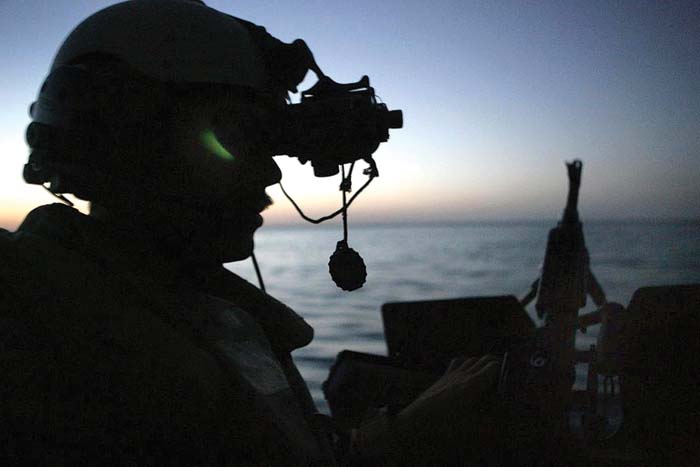
Lubrani: No we don’t. Not big fans of MREs (Meals Ready to Eat) but we do eat ‘em quite a lot. We keep ourselves entertained. We have camaraderie and that goes a long way…. There’s a brotherhood in being a Riverine: we’re a very tight knit. There’s roughly about three hundred of us in the squadron, broken down into three dets (detachments), about sixty people per det and a command element. Within that det we’re very, very close. Most of us know each others families, we get together quite often for barbecues, hanging out, birthday parties for our children, so it’s very tight knit.
SAR: Are you personally interested in firearms and shooting?
Lubrani: Absolutely. But believe it or not coming from Los Angeles, I had never even held a weapon before I joined the military. It made me nervous at first when you’ve got to do your qualifications. But now, with the Riverines, I actually qualified as an Expert shooter with both the pistol and rifle so I think I’ve come a long way. I’m a lot more comfortable around guns than when I first began. They’re a necessity. It’s a hard life out there sometime the way the world’s changing and I definitely think they’re a necessity.
SAR: Any personal firearms?
Lubrani: A Springfield XD in .40 S&W caliber. I wanted something a little more than a nine mil. My wife’s in the Navy as well and she’s used to the Beretta (M9). When we went to the range I taught her how to use the Beretta very well but I wanted something just a little more powerful for home protection. The XD’s a gun she felt comfortable with. No other weapons. We’ve got four children so money’s kind of tight.
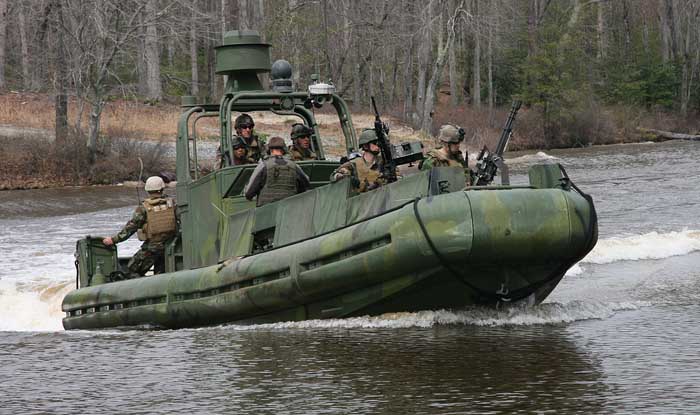
SAR: What formal schools and subsequent training have you received for your duties on the RST?
Lubrani: Our initial training was at Blackwater USA (security company in Moyoc, NC), a few weeks there that covered small arms, rifle, a little bit of CQB (Close Quarter Battle), and combat first aid. Then we deployed to Iraq. When we came back we went through another course at the Chesapeake Annex with land warfare and a little bit of land navigation, taught by ITA.
SAR: Do you believe you’ve had adequate training time?
Lubrani: Absolutely, we spend a good portion of the year just training, not only in an environment like this (AP Hill) but also self sustained training. We have qualified guys within our own detachment to run ranges and things like that and we’ve got plenty of ammunition.
SAR: How about computer simulators?
Lubrani: We’ve used those at Camp Lejeune. We all went through SOI (USMC School of Infantry) when the command was first established.
SAR: Night training with NVGs?
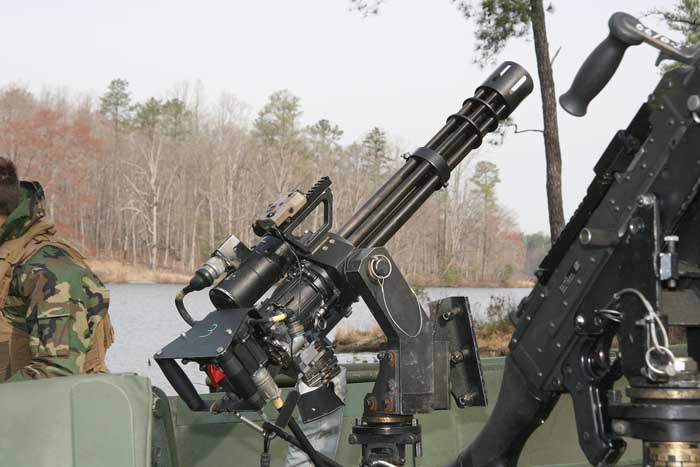
Lubrani: Absolutely, we spend a lot of time training with NVGs (PVS-14 Monocular Night Vision Goggle) not only on the boats but on land as well. The more we practice with them it helps because your depth perception is so much different (shallow) when you’re wearing ‘em.
SAR: What recommendations would you like to make to the chain of command to improve skill with individual weapons and the ability to operate day and night?
Lubrani: The NVGs we have now I enjoy. I’ve heard a couple of guys say they’d like to use a two-tube NVG (like the AN/PVS-15) for better depth perception. I like the single (tube) one because you never know. Someone can shine a light on you and they have a safety thing that’ll kick off (automatically shut down) but at least you still have one eye to engage with. With a binocular NVG you’d have to take time to lift ‘em up to see or wait for them to readjust.
SAR: Comment on the individual weapons used by the RST.
Lubrani: The 9mm Beretta, I love it, hasn’t failed me once. Keep it clean and it never jams up on you. The M4, I love that rifle, it’s great. It held up very well in Iraq with all the dust. I didn’t have a problem with it. None of the parts ever loosened up on me or anything like that. It’s a really good rifle.
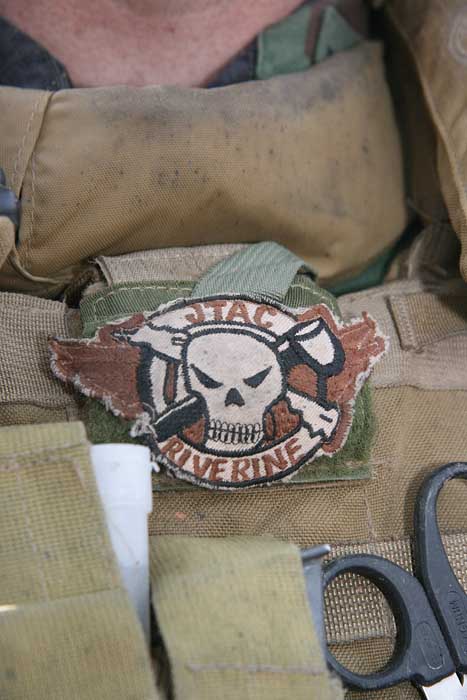
SAR: Most of the flattop M4s we’ve seen in your detachment have 4 power ACOG scopes mounted. Does anybody use a different scope or sight?
Lubrani: A couple of our RSTs have Aimpoints, a red dot sight. At first all of the RST guys got Aimpoints and all the boat guys got ACOGs. But now they’ve kinda switched up a little bit. Only because our Aimpoints don’t come with magnification. I know they sell one and I think that would be great. If it had both I think that’d be spot on. Or the one you mentioned (4 power ACOG with a piggyback DOCTER red dot) that sounds great. When we’re in Iraq there’s a lot of open space so you could use that magnification. But at the same time you never know when your convoy will break down in the middle of the town and you have to go in and search those buildings. You have to have both ‘cause you never know when you’re gonna need it.
SAR: When you were deployed was most of the RST work in going through villages?
Lubrani: Not really. We encountered a lot of tents, not too many buildings at all. We ground convoyed through towns but we didn’t stop to get out and search.
SAR: Would you make recommendations for any other gear like weapon-mounted night sights?
Lubrani: We’ve got the PEQ-15 (ATPIAL – Advanced Target Pointer Illuminator Aiming Light) and those are really good. We usually use them with the infrared laser pointer and we have our NVGs on and it hits, it picks up really good.
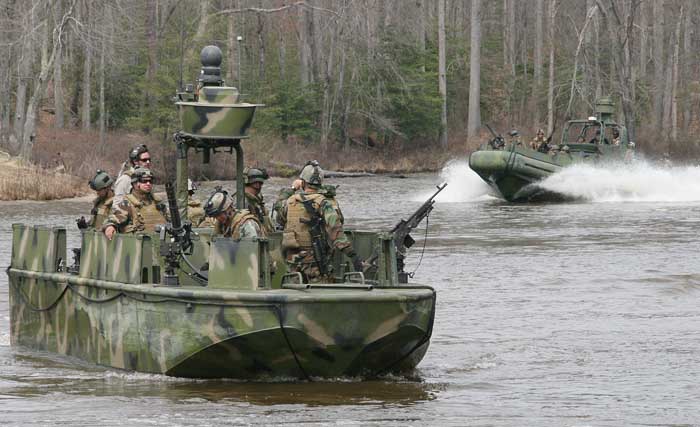
SAR: Any personal experience or stories you’ve heard about the effectiveness of M855 standard 5.56mm ball ammunition in stopping the target?
Lubrani: We’ve heard that there are times when they won’t. Maybe going to a heavier caliber for us would be better. I’ve personally never seen anyone shot with ‘556.’
SAR: Have you had the opportunity to use the 40mm M203 grenade launcher on an M4?
Lubrani: Yes, through training. It’s very well built, you can deploy it very quickly and these ITA instructors here have shown us a way that makes it even better. Usually we use leaf sights but they showed us a quicker way of engaging your target using reference points on the side of the rifle. Apparently comes from their experience in using it.
SAR: RSTs were previously using the MK43, a modified M60. We’re hearing some say they’re not happy with the new MK 48, that 7.62mm belt gun from FN. Comment?
Lubrani: I’ve had a lot of experience with the M240 and the 48 is almost the same as far as how it works and its cyclic rate. But the 48 for some reason was jamming. You wanna go out knowing you have something that’ll shoot. More than fifty or sixty rounds before its jams up on you. Being a small unit element we have two machine gunners and that’s it. So if one of those or both of those go down that’s a big gap in our firepower. We’ve heard rumors that it gets better after a certain amount of rounds. I don’t know if the parts open up and get looser and it’s more reliable. But as of right now; not good.
SAR: Tell us about the 12 gauge M500 Mossberg shotgun.
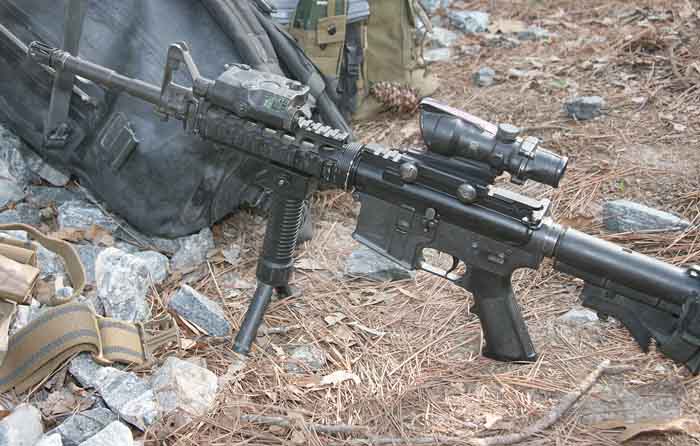
Lubrani: That’s probably gonna be our next home defense weapon (laughs) for my wife and I. On the team we haven’t had to employ it. Just in training. But among all the guys we love it. Put a slug in there and knock the hinges off a door real quick.
SAR: Do you have leeway in your gear? For example, the holster for your M9. Do you get to pick your own if you don’t like the Navy issue?
Lubrani: Yes, you see some guys with different types of holsters but for the most part we like to keep it all the same, like the SERPA (Blackhawk Industries), a great holster. If you notice most of our guys have Navy issue SERPAs with a one finger release. The only difference (points to LT Baer) would be like the LT is wearing his ‘drop leg’ and I’m wearing it hip platform. It just comes down to personal comfort.
SAR: Lieutenant, is that an issue rig?
Baer: I actually purchased this myself, a drop down with that extra gap below the body armor for a quicker draw.
SAR: How about variations in the types of magazine pouches and their positioning on the body armor?
Lubrani: At first it was a command thing, they wanted us to all be the same. But once we got into training it was realized that some things just don’t work for everybody. Everyone has a different way they grab their magazines, different places. And once you get into the training it all becomes muscle memory, you have to know where your things are. I’ve rigged mine five or six times in different positions just so I can get it to where it’s comfortable.
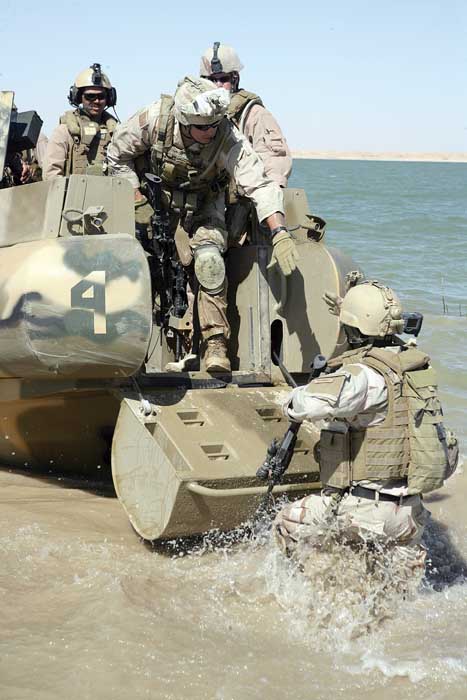
Baer: If you look at his mag pouches you can see how he’s got loops holding his mags and I have a different configuration. So it’s personal preference. The only thing these guys are held to is in our standard procedures we have first line, second line, third line gear. First line gear is the stuff you wear on you, like your emergency pack and holster. Second line is weapons and helmet, third line is what you’re gonna carry in your pack like GoreTex rain gear. As long as they have that gear in each of those lines they’re good to go.
SAR: Other tricks of the trade from real world experience on your individual weapons?
Lubrani: Most of our tricks of the trade have come through training. Just getting out here and practicing so much. Other things, I think the biggest one for me personally was learning how to shoot on your side. Sometimes you can’t always get the shot laying flat down in the prone position. Learning to manipulate your ACOG so your point’s still facing the same way. Same thing with your M9, holding the flashlight up when you’re coming into a room with your Beretta.
SAR: How about interaction with other RSTs? Do you get together to talk about what works and what doesn’t?
Lubrani: Absolutely, we’ll get with different dets and ask ‘em questions. Maybe see somebody with his gear rigged differently or his PEQ mounted on the side instead of on top. We bounce things off each other all the time.
SAR: We’ve seen different types of foregrips on the M4s. Some have the GripPod with little bipod legs that drop down. Also tactical lights and pressure switches for the M4. Are these regulation, available through the Navy supply system?
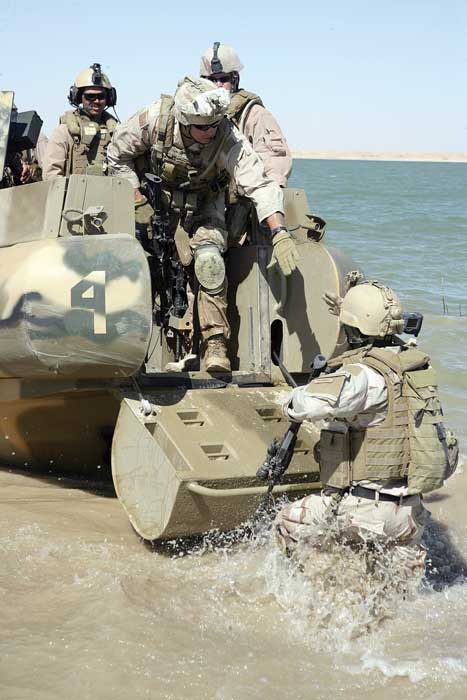
Lubrani: Usually our armory guys take care of all that stuff. They have a list of approved things we can use on there. The accessories we can vary up a little bit. Personal preference. A lot of guys go out and buy their own. From what I understand it’s the same pretty much in other units like the SEALs. As long as it fits the Navy’s requirement.
SAR: Your magazines don’t have pull loops.
Lubrani: Some of the guys do have ‘em, including MagPul. I’ve got short fingers and I don’t really like ‘em too much (laughs).
SAR: What happens when you’re in country and something breaks on the weapons?
Baer: It goes through the regular Navy maintenance system. We can get parts replacements and we have spare parts we can use to fix our weapons. If something goes down hard then they send it back to (NSWC) Crane and we’ll get a full replacement. We have spare weapons in the detachment.
SAR: What lessons did you learn about yourself and your boat mates in your last deployment?
Lubrani: It was pretty hot over there. The worst part is for the guys on the boats who have a different vest than we RSTs do. It’s a KDH (Tactical Maritime Body Armor System) and ours are Eagle Industries (Maritime Combat Integrated Releasable Armor System). From personal experience the KDH is so cumbersome. It feels like you’ve got twenty extra pounds on. This Eagle feels lighter even though the (ballistic) plates probably weigh about the same. I’m actually carrying more stuff than I was on the boat but it’s the maneuverability.
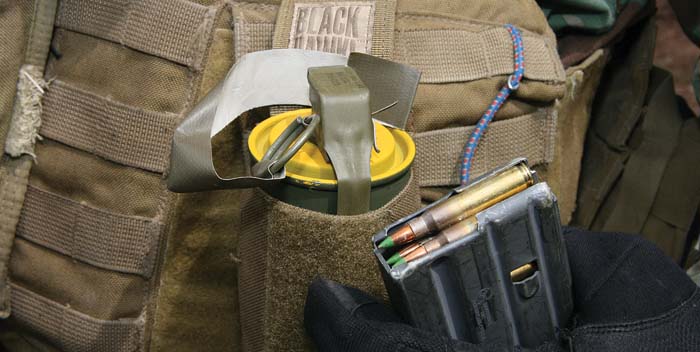
SAR: Why do they wear a different vest?
Baer: The boat guys have more chance of being hit with shrapnel and debris from the boat if it comes under attack. If you look at the KDH the boat guys have it’s gonna ride up higher under the arms and actually drops down lower. It has more flak protection built into the jacket of the vest itself and that’s why it’s heavier. The shoulder straps are wider and has protection that goes up into the shoulder areas. The Eagle has a little less flak protection.
SAR: How about the actual ballistic plates?
Baer: They are the same, 7.62mm ESAPI (Enhanced Small Arms Protective Insert).
SAR: You’d sink like a rock in these heavy things if you went over the side. What keeps you floating?
Baer: This ‘horse collar’ automatically inflates and it will keep your head above the water. Sometimes they go off when you’re just getting wet in training…
Lubrani: The vests come with a quick release that you pull and it drops the ballistic plates.
Baer: A configuration we’re expecting in the future is where, instead of having the ‘horse collar,’ we’ll have foam floatation inserts that go into the vest itself and ride between the plates and your body.
SAR: What advice do you have for RSTs preparing for their first deployment?
Lubrani: It can be something as simple as what to pack and what to expect out there. Morale is the most important thing. When they leave for deployment they should make sure everything at home is organized because nothing will bring you down worse than that.
SAR: What would you like to say to young men considering joining the Navy about why they should choose Riverine?
Lubrani: We’re a very unique unit. SWCC (Special Warfare Combatant Craft) says they’re the Riverines – I beg to differ – we carry that name now. I think because of the veterans from Vietnam we have a big name to live up to and so far we’ve very much done so. We’ve got big shoes to fill. It’s a hard life, you’re constantly training but you’re getting paid to come out here and shoot guns all day. What more can you ask for? Shoot guns, PT (physical training), a big camping trip with live fire and boats. It’s great and there’s nothing else like it. ‘Big Navy’ doesn’t have that. We were out here yesterday training, soaking wet and cold in the Zodiacs, and I turned around and said to the ITA instructor, ‘we’re actually getting paid to do this…’
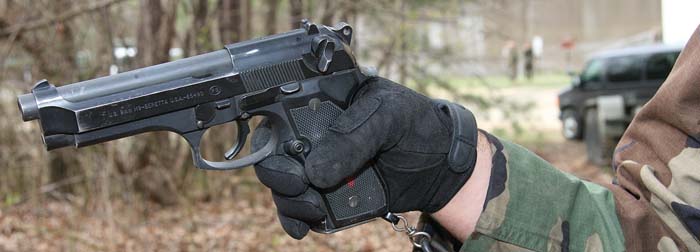
SAR: What would you like to add to any of this?
Lubrani: It wouldn’t be such a great experience without the people around you. The team, the entire det that makes it so good, the camaraderie. My own experience would be as a high school athlete and the kind of solidarity you have with your teammates. That’s exactly what it’s like here and I wouldn’t be here today if it wasn’t like that.
SAR: Lieutenant, did you ask for Riverine?
Baer: I did and it has lived up to my expectations. I joined the unit in November 08 when the first group of the detachment returned from Iraq. I took the Riverine Unit Level Leader’s Course at Lejeune’s SMTC (Special Missions Training Center) for good baseline knowledge. This unit is a good place to be and I enjoy it. It’s a lot of time away from home but it makes it worthwhile when you get to go out here and do the things we do.
SAR: Still no word on where and when for the next deployment?
Baer: Yeah, we’re standing by. We keep appraised and abreast of what’s going on in Iraq with our other squadrons because we need to know if we are going to relieve them in the same place and where we’ll take up from where they left off.
SAR: Your boats are painted green. Will you leave these behind if you go back to Iraq?
Baer: Yes, the other squadron in Iraq will turn theirs over if or when we relieve them. They get a regular supply chain of new equipment and parts, maintenance on the boats themselves.
SAR: Will you leave your weapons behind?
Baer: No, the weapons come with us, but the boats, trucks and trailers we’re using now will stay. RIVGRU ONE keeps them in rotation for stateside training.
(Editor’s Note: Since these interviews were conducted, RIVRON 3 has learned where their next deployment will be. SAR sends our wishes to them for fair winds and following seas.)
Find out more: Navy Expeditionary Combat Command — www.necc.navy.mil
| This article first appeared in Small Arms Review V13N8 (May 2010) |












